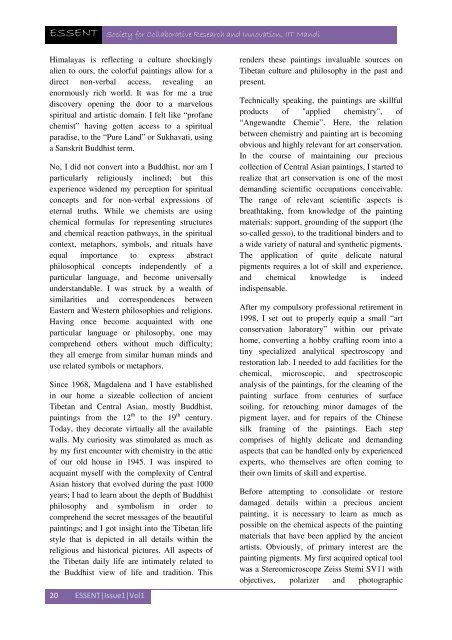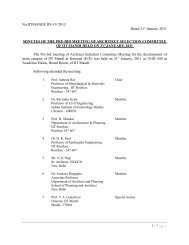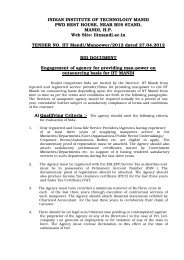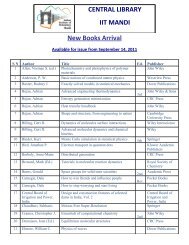Issue1. Vol.1 (April, 2013) - IIT Mandi
Issue1. Vol.1 (April, 2013) - IIT Mandi
Issue1. Vol.1 (April, 2013) - IIT Mandi
- No tags were found...
You also want an ePaper? Increase the reach of your titles
YUMPU automatically turns print PDFs into web optimized ePapers that Google loves.
ESSENT Society for Collaborative Research and Innovation, <strong>IIT</strong> <strong>Mandi</strong>Himalayas is reflecting a culture shockinglyalien to ours, the colorful paintings allow for adirect non-verbal access, revealing anenormously rich world. It was for me a truediscovery opening the door to a marvelousspiritual and artistic domain. I felt like “profanechemist” having gotten access to a spiritualparadise, to the “Pure Land” or Sukhavati, usinga Sanskrit Buddhist term.No, I did not convert into a Buddhist, nor am Iparticularly religiously inclined; but thisexperience widened my perception for spiritualconcepts and for non-verbal expressions ofeternal truths. While we chemists are usingchemical formulas for representing structuresand chemical reaction pathways, in the spiritualcontext, metaphors, symbols, and rituals haveequal importance to express abstractphilosophical concepts independently of aparticular language, and become universallyunderstandable. I was struck by a wealth ofsimilarities and correspondences betweenEastern and Western philosophies and religions.Having once become acquainted with oneparticular language or philosophy, one maycomprehend others without much difficulty;they all emerge from similar human minds anduse related symbols or metaphors.Since 1968, Magdalena and I have establishedin our home a sizeable collection of ancientTibetan and Central Asian, mostly Buddhist,paintings from the 12 th to the 19 th century.Today, they decorate virtually all the availablewalls. My curiosity was stimulated as much asby my first encounter with chemistry in the atticof our old house in 1945. I was inspired toacquaint myself with the complexity of CentralAsian history that evolved during the past 1000years; I had to learn about the depth of Buddhistphilosophy and symbolism in order tocomprehend the secret messages of the beautifulpaintings; and I got insight into the Tibetan lifestyle that is depicted in all details within thereligious and historical pictures. All aspects ofthe Tibetan daily life are intimately related tothe Buddhist view of life and tradition. This20 ESSENT|Issue1|Vol1renders these paintings invaluable sources onTibetan culture and philosophy in the past andpresent.Technically speaking, the paintings are skillfulproducts of "applied chemistry", of“Angewandte Chemie”. Here, the relationbetween chemistry and painting art is becomingobvious and highly relevant for art conservation.In the course of maintaining our preciouscollection of Central Asian paintings, I started torealize that art conservation is one of the mostdemanding scientific occupations conceivable.The range of relevant scientific aspects isbreathtaking, from knowledge of the paintingmaterials: support, grounding of the support (theso-called gesso), to the traditional binders and toa wide variety of natural and synthetic pigments.The application of quite delicate naturalpigments requires a lot of skill and experience,and chemical knowledge is indeedindispensable.After my compulsory professional retirement in1998, I set out to properly equip a small “artconservation laboratory” within our privatehome, converting a hobby crafting room into atiny specialized analytical spectroscopy andrestoration lab. I needed to add facilities for thechemical, microscopic, and spectroscopicanalysis of the paintings, for the cleaning of thepainting surface from centuries of surfacesoiling, for retouching minor damages of thepigment layer, and for repairs of the Chinesesilk framing of the paintings. Each stepcomprises of highly delicate and demandingaspects that can be handled only by experiencedexperts, who themselves are often coming totheir own limits of skill and expertise.Before attempting to consolidate or restoredamaged details within a precious ancientpainting, it is necessary to learn as much aspossible on the chemical aspects of the paintingmaterials that have been applied by the ancientartists. Obviously, of primary interest are thepainting pigments. My first acquired optical toolwas a Stereomicroscope Zeiss Stemi SV11 withobjectives, polarizer and photographic
















